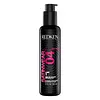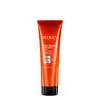What's inside
What's inside
 Key Ingredients
Key Ingredients

No key ingredients
 Benefits
Benefits

 Concerns
Concerns

 Ingredients Side-by-side
Ingredients Side-by-side

Water
Skin ConditioningPropylene Glycol
HumectantDimethicone
EmollientAmodimethicone
Isopropyl Myristate
EmollientTriethanolamine
BufferingPhenoxyethanol
PreservativeParfum
MaskingPEG-40 Hydrogenated Castor Oil
EmulsifyingPEG/PPG-17/18 Dimethicone
EmulsifyingCarbomer
Emulsion StabilisingPolyquaternium-4
Polyquaternium-6
Potato Starch Modified
Hydroxypropyl Guar
Emulsion StabilisingCaprylyl Glycol
EmollientDimethiconol
EmollientTocopheryl Acetate
AntioxidantXylose
HumectantTrideceth-6
EmulsifyingCetyl Alcohol
EmollientBenzophenone-4
UV AbsorberQuaternium-87
CleansingBehentrimonium Methosulfate
Cetrimonium Chloride
AntimicrobialQuaternium-33
Vaccinium Macrocarpon Seed Oil
Skin Conditioning2-Oleamido-1,3-Octadecanediol
Skin ConditioningHydroxyisohexyl 3-Cyclohexene Carboxaldehyde
MaskingBenzyl Alcohol
PerfumingCitronellol
PerfumingWater, Propylene Glycol, Dimethicone, Amodimethicone, Isopropyl Myristate, Triethanolamine, Phenoxyethanol, Parfum, PEG-40 Hydrogenated Castor Oil, PEG/PPG-17/18 Dimethicone, Carbomer, Polyquaternium-4, Polyquaternium-6, Potato Starch Modified, Hydroxypropyl Guar, Caprylyl Glycol, Dimethiconol, Tocopheryl Acetate, Xylose, Trideceth-6, Cetyl Alcohol, Benzophenone-4, Quaternium-87, Behentrimonium Methosulfate, Cetrimonium Chloride, Quaternium-33, Vaccinium Macrocarpon Seed Oil, 2-Oleamido-1,3-Octadecanediol, Hydroxyisohexyl 3-Cyclohexene Carboxaldehyde, Benzyl Alcohol, Citronellol
Water
Skin ConditioningCetearyl Alcohol
EmollientOrbignya Oleifera Seed Oil
EmollientParfum
MaskingGlycerin
HumectantBehentrimonium Chloride
PreservativeCetrimonium Chloride
AntimicrobialAmodimethicone
Sodium Benzoate
MaskingIsopropyl Alcohol
SolventPEG/PPG/Polybutylene Glycol-8/5/3 Glycerin
HumectantBenzyl Salicylate
PerfumingCitric Acid
BufferingBenzyl Alcohol
PerfumingLinalool
PerfumingTrideceth-6
EmulsifyingChlorhexidine Dihydrochloride
AntimicrobialHexyl Cinnamal
PerfumingGeraniol
PerfumingAmyl Cinnamal
PerfumingCoumarin
PerfumingCitronellol
PerfumingLimonene
PerfumingBenzyl Benzoate
AntimicrobialWater, Cetearyl Alcohol, Orbignya Oleifera Seed Oil, Parfum, Glycerin, Behentrimonium Chloride, Cetrimonium Chloride, Amodimethicone, Sodium Benzoate, Isopropyl Alcohol, PEG/PPG/Polybutylene Glycol-8/5/3 Glycerin, Benzyl Salicylate, Citric Acid, Benzyl Alcohol, Linalool, Trideceth-6, Chlorhexidine Dihydrochloride, Hexyl Cinnamal, Geraniol, Amyl Cinnamal, Coumarin, Citronellol, Limonene, Benzyl Benzoate
Ingredients Explained
These ingredients are found in both products.
Ingredients higher up in an ingredient list are typically present in a larger amount.
This water-soluble silicone is used for its hydrating and softening properties. It is used to add a silky feel to skincare products and has great benefits for haircare.
In haircare, this ingredient:
- Adds shine
- Protects color
- Offers thermal protection
- Boosts hair strength
- Does not build up as easily
Benzyl Alcohol is most commonly used as a preservative. It also has a subtle, sweet smell. Small amounts of Benzyl Alcohol is not irritating and safe to use in skincare products. Most Benzyl Alcohol is derived from fruits such as apricots.
Benzyl Alcohol has both antibacterial and antioxidant properties. These properties help lengthen the shelf life of products. Benzyl Alcohol is a solvent and helps dissolve other ingredients. It can also improve the texture and spreadability.
Alcohol comes in many different forms. Different types of alcohol will have different effects on skin. This ingredient is an astringent alcohol.
Using high concentrations of these alcohols are drying on the skin. They may strip away your skin's natural oils and even damage your skin barrier. Astringent alcohols may also irritate skin.
Other types of astringent alcohols include:
According to the National Rosacea Society based in the US, you should be mindful of products with these alcohols in the top half of ingredients.
Any type of sanitizing product will have high amounts of alcohol to help kill bacteria and viruses.
Learn more about Benzyl AlcoholThis ingredient is a preservative, antimicrobial, and emulsifier. It is often used in cosmetics for its ability to cleanse, condition, and reduce static.
Cetrimonium chloride is a quaternary ammonium salt, meaning it has a water-soluble structure.
Citronellol is used to add fragrance/parfum to a product. It is often derived from plants such as roses. In fact, it can be found in many essential oils including geranium, lavender, neroli, and more. The scent of Citronellol is often described as "fresh, grassy, and citrus-like".
Since the Citronellol molecule is already unstable, Citronellol becomes irritating on the skin when exposed to air.
Citronellol is a modified terpene. Terpenes are unsaturated hydrocarbons found in plants. They make up the primary part of essential oils.
Citronellol is not able to be absorbed into deeper layers of the skin. It has low permeability,
Citronellol is also a natural insect repellent.
Learn more about CitronellolParfum is a catch-all term for an ingredient or more that is used to give a scent to products.
Also called "fragrance", this ingredient can be a blend of hundreds of chemicals or plant oils. This means every product with "fragrance" or "parfum" in the ingredients list is a different mixture.
For instance, Habanolide is a proprietary trade name for a specific aroma chemical. When used as a fragrance ingredient in cosmetics, most aroma chemicals fall under the broad labeling category of “FRAGRANCE” or “PARFUM” according to EU and US regulations.
The term 'parfum' or 'fragrance' is not regulated in many countries. In many cases, it is up to the brand to define this term.
For instance, many brands choose to label themselves as "fragrance-free" because they are not using synthetic fragrances. However, their products may still contain ingredients such as essential oils that are considered a fragrance by INCI standards.
One example is Calendula flower extract. Calendula is an essential oil that still imparts a scent or 'fragrance'.
Depending on the blend, the ingredients in the mixture can cause allergies and sensitivities on the skin. Some ingredients that are known EU allergens include linalool and citronellol.
Parfum can also be used to mask or cover an unpleasant scent.
The bottom line is: not all fragrances/parfum/ingredients are created equally. If you are worried about fragrances, we recommend taking a closer look at an ingredient. And of course, we always recommend speaking with a professional.
Learn more about ParfumWe don't have a description for Trideceth-6 yet.
Water. It's the most common cosmetic ingredient of all. You'll usually see it at the top of ingredient lists, meaning that it makes up the largest part of the product.
So why is it so popular? Water most often acts as a solvent - this means that it helps dissolve other ingredients into the formulation.
You'll also recognize water as that liquid we all need to stay alive. If you see this, drink a glass of water. Stay hydrated!
Learn more about Water